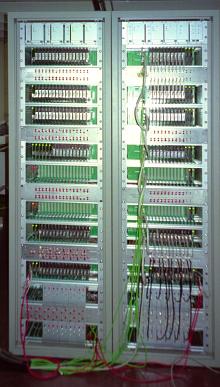VSA Correlator

What makes an interefrometer "an interferometer" is the correlator which combines all possible pairs of antennas or "baselines". This pulls out the common correlated electromagnetic signals from the astronomical object being observed from all the uncorrelated noise from the amplifiers, atmosphere and surroundings.
The correlator works by multiplying the two signals together and integrating. The wanted signal is in itself 'noise-like' electrical voltage, but since it goes up and down together in the two antennas it ends up multplying by itself and integrates up, which the noise doesn't.
With 14 antennas there are 91 possible pairs, but as there are two channels (complex real and imaginary) per pair, 182 correlator channels are required. This leads to a lot of cables to distribute the signals over the correlator.


